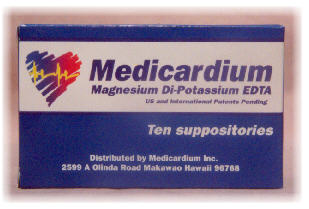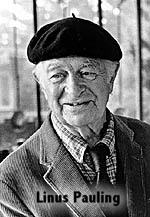Find Your Risk of Heart Disease or
Cancer by Blood Type - With & Without Chelation!
Aging & Chelation The Silent Threat: Subclinical Toxic Metal Exposure
The Silent Threat: Subclinical Toxic Metal Exposure
FAQ An Interview With The Inventor of
Medicardium
An Interview With The Inventor of
Medicardium
Chelatox: Same Formula - Lower Price
Aging & Chelation
FAQ
Chelatox: Same Formula - Lower Price
 Medicardium is the first OTC product
that allows anyone to enjoy the benefits of chelation therapy in
the privacy of their own home -- without the needles.
EDTA chelation has been shown to decrease
the risk of heart attack by 86% (1); the risk of dying by cancer 90% (2);
and is well-known for its ability to remove toxic heavy metals in the body
that correspond to accelerated aging.
Medicardium is the first OTC product
that allows anyone to enjoy the benefits of chelation therapy in
the privacy of their own home -- without the needles.
EDTA chelation has been shown to decrease
the risk of heart attack by 86% (1); the risk of dying by cancer 90% (2);
and is well-known for its ability to remove toxic heavy metals in the body
that correspond to accelerated aging.Medicardium (10 suppositories) -- $ 99.95
Code 130 ---- [ Availability ]
- Problems with Oral Chelation. EDTA taken orally (oral chelation) can interfere with digestion, absorption, and metabolic function. The primary purpose of the small intestines is to aid the body in assimilating nutrients. To add a powerful mineral sequestering agent to foodstuffs is self-defeating. No wonder most users report it is largely ineffective. (Incidentally, food-grade EDTA is used as a preservative by food manufacturers to bind copper, iron and other ions so that foods take better longer. Food processors don't use near the level of EDTA that people in the supplement market do.)
- Time Commitment for Intravenous. Although there is no question that intravenous chelation really works, who has time to sit in a doctor's chair for 3 hours (the standard protocol for the "full bag," 3 gram dosage)? Now multiple this by the recommended 20 to 30 treatments and you're talking a major career change. This is onerous even for people who are retired, and considering the cost, what they need to do is add a complimentary sleeping bag and a Coleman stove --- since your doctor's office will be your new temporary residence.
- Accessibility. Only certain doctors in certain doctors perform intravenous chelation therapy. This makes accessibility a real issue. Some people have to travel considerable distances, and that's a hassle.
- Then There's the Needles & the Discomfort. It may seem a trivial personal preference, but some people don't enjoy getting stuck with a needle so many times, they look like a heroin addict. This author is here to tell you from personal experience that those of you who get the Vitamin C adjunct are in for a special treat. If there's a better way, why not take it?
- Ease of Use. Medicardium is easy to use and comes with easy to follow directions and warning (contraindications).
- Easier to Handle Dosage. A 3 hour chelation session
supplies 3 grams (3,000 mg.) of EDTA; a 90 minute "short bag"
session supplies 1.5 grams. Even on the short program, this
author was so dizzy he had to be driven home. With
Medicardium, each suppository is only 365 mg. of
Magnesium Di-Potassium EDTA, so it is not nearly
as disruptive to the physiology. Tests conducted
by the product's maker, showed a 92% absorption rate,
and you can take the suppositories at your own pace.
(It is recommended to take one every three days, or
as recommended by your health care provider.)
- Study by Dr. Walter Blumer (M.D.),
Switzerland.
- Ninety percent reduction in cancer mortality after chelation therapy with
EDTA. w. Blumer, M.D., Elmber Cranton, M.D. Journal of Advancement in
Medicine, Vol. 2, Numbers 1/2, pg. 183.
The Fundamentals
Elmer M. Cranton, M.D. James P. Carter, M.D.
James P. Carter, M.D.
Elmer M. Cranton, M.D.
(Includes a "Therapeutic History of Chelation Therapy")

(Rebuttal to Critics of EDTA Chelation Therapy)
Potential Benefits of EDTA Chelation
Prevents cholesterol deposits Reduces blood cholesterol levels Lowers high blood pressure Avoids by-pass surgery Avoids angioplasty Reserves digitalis toxicity Removes calcium from atherosclerotic plaques Dissolves intra-arterial blood clots Normalizes cardiac arrythmias Has an anti-aging effect Reduces excessive heart contractions Increases intracellular potassium Reduces heart irritability Improves heart function Removes mineral and drug deposits Dissolves kidney stones Reduces serum iron levels Reduces heart valve calcification Reduces varicose veins Heals calcified necrotic ulcers Reduces intermittent claudication Improves vision in diabetic retinopathy Decreases macular degeneration Dissolves small cataracts Eliminates heavy metal toxicity Makes arterial walls more flexible Prevents osteoarthritis Reduces rheumatoid arthritis symptoms Lowers diabetics' insulin needs Reduces Alzheimer-like symptoms Reverses senility Reduce stroke/heart attack after-effects Prevents cancer Improves memory Reverses diabetic gangrene Restores impaired vision Detoxifies snake and spider venoms* Adapted from Walker M., Gordon G.,
Douglass W.C. The Chelation Answer